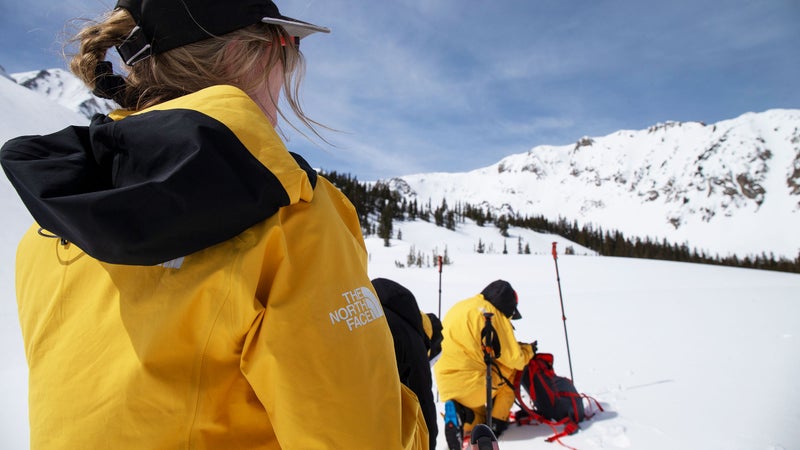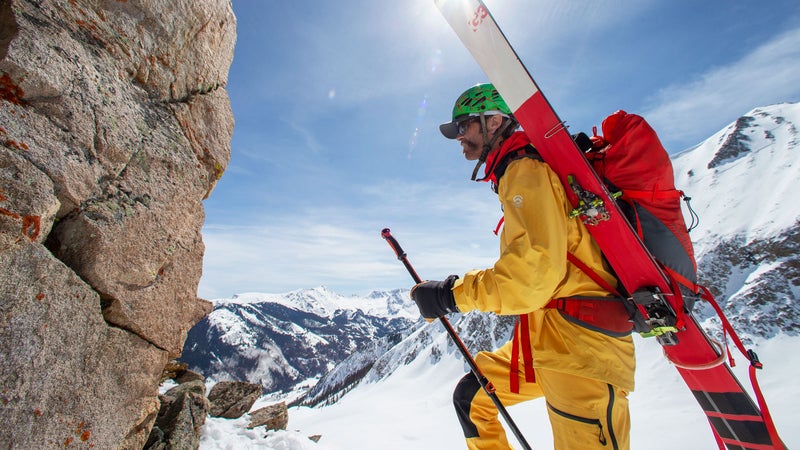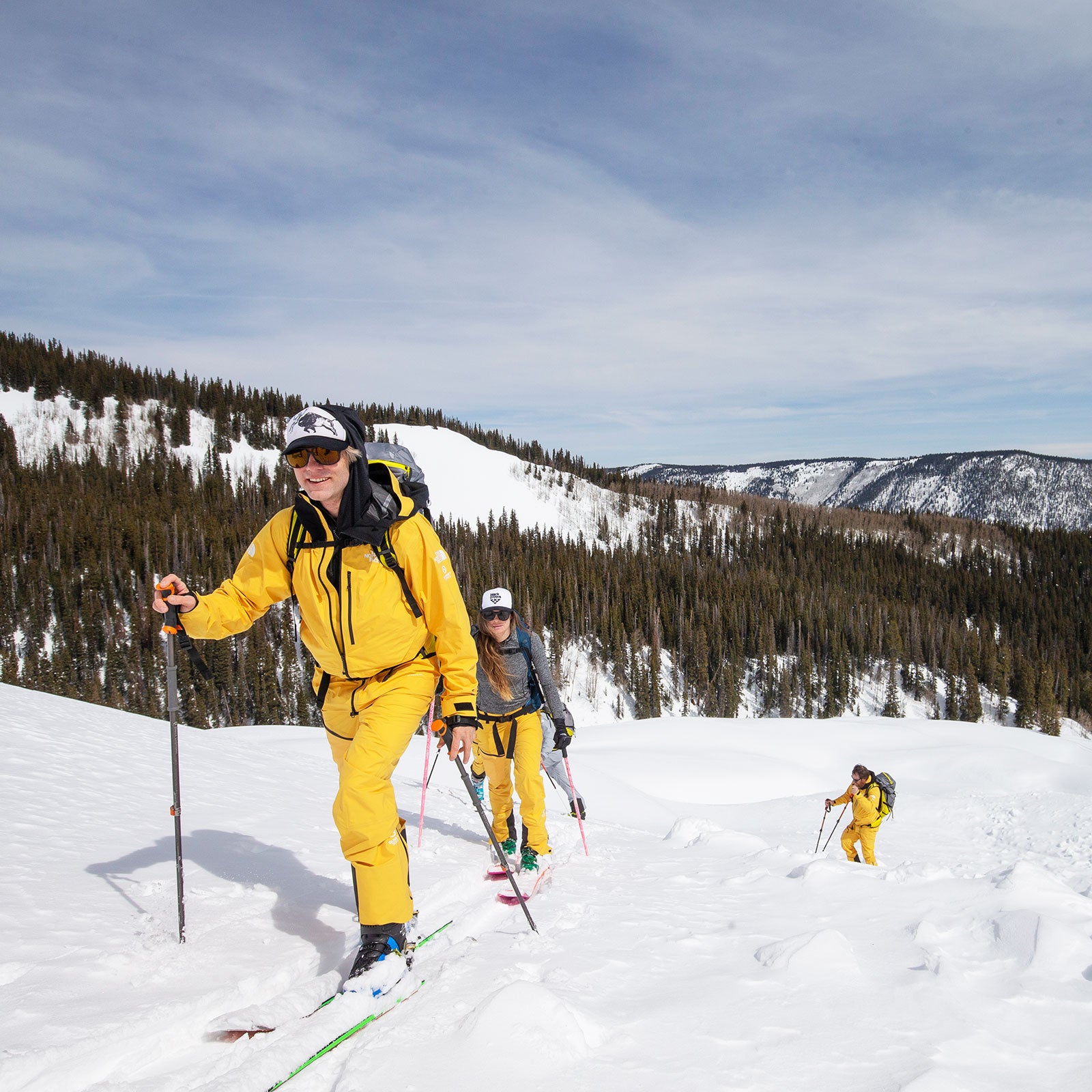The outdoor-gear marketplace is already awash with myriad waterproof-breathable membranes, and Gore-Tex has set the standard for decades. But this winter, the North Face claimed it had made the most advanced one yet. Dubbed , the new technology will make its way into some 30 different products this fall, from jackets and pants to gloves and single-wall tents. Up until now, the North Face has exclusively used Gore-Tex, and after the announcement, many people were wondering how well Futurelight would stack up.
Since a preview event in Aspen, Colorado, in late March, I’ve been testing the new material to find out.
The Tech
Futurelight is a three-layer fabric comprised of a waterproof-breathable membrane sandwiched between a tough external fabric and a soft liner (the typical construction in high-end shells). The membrane is a web of polyester fibers, extruded from 220,000 tiny nozzles and laid in a sheet. The spaces between the fibers are too small for water to penetrate but large enough for vapor from perspiration to escape. It’s similar to, if not the same as, the process used to make and —also air-permeable membranes. But it differs from Gore-Tex, which relies on a sheet of polytetraflouroethylene (a plastic similar to polyurethane) that’s stretched enough to create pores that vapor can pass through. Traditionally, Gore-Tex hasn’t been as breathable as air-permeable membranes, but it’s been a little more waterproof.
The North Face can adjust the porosity, hardiness, and stretch of Futurelight by tweaking the density of the fibers, the thickness of the membrane (by laying more or fewer fibers), and the amount of glue used to adhere the fabric’s layers together. Put simply, the membrane can be fine-tuned to be more breathable or more durable, depending on the garment’s intended use. One flavor of Futurelight can be created for a superlight, superbreathable trail-running jacket, while another, tougher version can be constructed for snowboarding at the resort. But to be clear, this isn’t a first—Polartec’s NeoShell is created in much the same way, and the brand’s Power Shield Pro is simply a less dense, and therefore more breathable, version of NeoShell. (And while Gore uses a different construction process, it does have a range of membranes that span the spectrum of breathability, from burly Pro to lighter, airier Active.)
One significant difference between Futurelight and Polartec’s air-permeable membranes is that that the company developed its own breathable, stretchier seam tape, says Scott Mellin, global general manager of the North Face’s mountain-sports division. That’s a bigger deal than it sounds, since seam tape traditionally has limited the breathability and stretch that garments can achieve. More seam tape means better waterproofing, but at the same, it time prevents vapor from escaping through the seams.
In addition, every Futurelight garment will consist of recycled face and backer fabrics—laminated to the membrane—and use a PFC-free chemical waterproof coating.
The Test

In a pair of all-day ski tours, I wore prototypes of the Summit L5 LT jacket and pants ($450 each). Made of one of the lightest and most breathable versions of Futurelight, they’re intended for high-output activities like ski mountaineering. The fabric is as supple and stretchy as any hard shell I’ve used, thanks in part to how thin the fabric is. The Summit L5 LT pieces were also remarkably light (11.9 ounces for the jacket, 9.1 for the pants), even with a solid feature set—the jacket, for instance, includes two large pockets, an adjustable, helmet-compatible hood, and cinches at the waist and cuffs. What’s notable is that the garments lack zippered vents, which many brands use to provide extra breathability. The absence of zippers reduces weight and improves fit but puts pressure on the fabric to deliver breathability.
In my experience, it did. On the first day in the Elk Mountains outside of Aspen, my group skinned up and skied down powder fields surrounding a 13,000-foot ridge near Snowmass. And on the second day, we made a three-hour ascent of a remote 12,800-foot peak. On both excursions, with the temperature ranging from 25 to 40 degrees, I was able to keep the jacket zipped up, even chuffing uphill, and never sweated through my base layer. To be sure, I could feel the tingle of air leaking in under stiff winds. But it’s usually easier to layer up to add warmth than it is to strip down to prevent perspiration.
Now, the North Face won’t release technical performance specs like vapor transmission rates until the fall, when Futurelight products go on sale, and it has requested that journalists don’t yet use third-party testing. So for now, we can’t get firm numbers for exactly how the membrane will perform versus the competition.
But since the March event, the Summit L5 LT has proved to be exceptionally breathable compared to other waterproof outerwear, much more so than any lightweight three-layer Gore-Tex shell I’ve used—like the Black Crows Ventus Light or the jackets. And it’s even more breathable than other air-permeable NeoShell options, like the Westcomb Apoc jacket.
With that breathability, there’s the perception that the Summit L5 LT wouldn’t stave off rain and moisture as well as other waterproof-breathable offerings like Gore-Tex over hours of continuous rain. After intense use, DWR coatings can wear off and moisture can find its way into a garment. At the preview, water from melting snow beaded right off the fabric. And while sunny weather in Aspen meant I didn’t have a chance to gauge waterproofing under significant precipitation, the jacket has stayed absolutely dry in my weeks of testing in snowy conditions since the March event. But it still remains to be seen how it handles a full-on deluge.
The Summit L5 LT version of Futurelight is exceptionally thin and requires you to take some care to avoid abrasion or puncturing—though the fabric didn’t look any worse for wear after a couple days of us shouldering skis and bashing through dense timber at the base of our tours.
The Upshot

With remarkable breathability, the Summit L5 LT is an excellent choice for any backcountry kit. It’s more breathable than most hard shells I’ve tested, and it’s lighter than any non-seam-taped soft shell I’ve used. The only downside may be durability, which is always a trade-off for light weight. Though the shell and pants have held up fine since that brief tryout in March, we’re still putting them through the wringer while testing for our 2020 Winter Buyer’s Guide. And of course, the North Face has other Futurelight models geared toward more durability.
Look for a more thorough test as we get more time with Futurelight.


